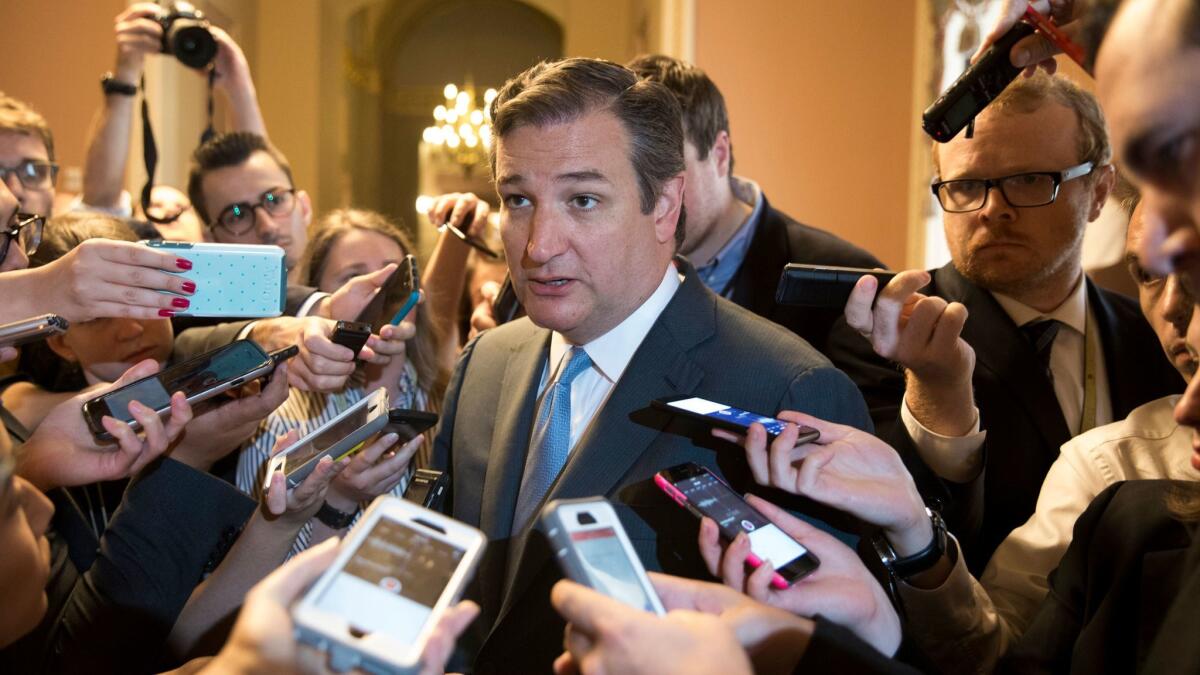Column: Here are the hidden horrors in the Senate GOP’s new Obamacare repeal bill

Senate Republicans unveiled a new, “improved” version of their Affordable Care Act repeal bill Thursday, so the treasure hunt is on: the search for provisions so horrifically inhumane that they’ve had to be concealed deep in the measure’s legislative language and procedural maze.
We’ve found quite a few, with the help of professional spelunkers Andy Slavitt, David Anderson, Larry Levitt and others. Here are some of the provisions in the so-called Better Care Reconciliation Act, or BCRA, that the Senate GOP really doesn’t want you to know about.
—The measure kills the birth control and women’s health screening requirements. The Affordable Care Act advanced women’s healthcare rights immensely by mandating that health plans cover contraceptives, as well as a range of preventive screenings, without deductibles or co-pays. Conservatives have been trying to roll back those guarantees since the ACA’s enactment. The new Senate bill eliminates them.
The bill is a giant ‘Trust Tom Price’ bill.
— Former Medicare/Medicaid administrator Andy Slavitt
That action is part of the Cruz Amendment, on which more below. It allows states to authorize the sale of health plans that don’t include the women’s health provisions. Observes Dawn Laguens of Planned Parenthood, “Insurance companies would once again be allowed to refuse to cover basic preventive healthcare, as well as charge women co-pays for birth control, immunizations and cancer screenings.” She calls this “a major step backward for women.”
—HHS Secretary Tom Price gets enormous new power over healthcare standards and even state budgets. The essence of the amended bill’s bait-and-switch structure is the creation of several slush funds to moderate the costs to states of various repeal provisions, especially the drastic cutback in Medicaid funding.
Those slush funds, however, would come under the control of Health and Human Services Secretary Tom Price. A known enemy of Medicaid and of expanding healthcare services for women and the needy, Price would have the authority to apportion those funds as he wishes, favoring some states over others because of their politics and policies, for example.
As former Medicare/Medicaid chief Andy Slavitt observes, there are no rules or standards guiding Price’s hand — he could dole out all the money to red states or pull funding from others at will. The money doesn’t have to go to services for low-income people or to replace lost Medicaid funding. He could shortchange states that require health plans to cover abortion — such as California and New York.
“The bill is a giant ‘Trust Tom Price’ bill,” Slavitt tweeted. And even if the money is apportioned responsibly, it’s not enough: The total in the slush funds, Slavitt calculates, would restore barely 10% of the cuts in Medicaid.
—The bill still cuts taxes for the wealthy. One widely noticed change from the original Senate bill is the retention of two taxes the ACA imposes on high-income taxpayers — those earning more than $200,000, or $250,000 for couples. These are a 3.8% surcharge on capital gains and dividends and a 0.9% increase in the Medicare tax for those taxpayers. The original Senate bill would have repealed those taxes, handing over an estimated $346-billion windfall to the rich over 10 years.
But don’t cry for the wealthy just yet. The amendment expands another windfall — health savings accounts, which are tax-preferred accounts that can be used to pay for out-of-pocket medical expanses. Under the amended bill, HSAs also can be used to pay premiums, which effectively renders premiums in the individual market tax-deductible for the first time.
HSAs sound good in principle, but in practice they’re geared to higher-income taxpayers. Although some employers help their workers fund HSAs, for the most part the accounts have to be funded out of disposable income, which many middle- and working-class families may find hard to come by. A study released this month by the Employee Benefit Research Institute found that, although the maximum annual contribution is $6,750 for families and $3,450 for individuals, the average total account contribution was $2,922 in 2016.
The Tax Policy Center says that more than 16% of all households with $200,000 in income or more have HSAs — but fewer than 2% of households earning less than $30,000 do.
The Republican repeal bills would raise the maximum contributions to $6,550 for individuals and $13,100 for families — but since most families can’t even max out their HSAs now, they plainly wouldn’t be helped by this change. Rich families would be helped, however.
—The senators exempt themselves from the loss of consumer protections. A convoluted provision in the amended measure exempts Congress and its staff members from the loss of guarantees for those with preexisting conditions and other consumer protections.
You won’t find the words “Congress” and “exemption” next to each other anywhere in the bill. You have to know that “1312(d)(3)(D)” is the provision of the Affordable Care Act requiring members of Congress and their staffs to obtain coverage through the Obamacare exchanges, and then notice, on Page 167 of the Senate bill, that the elimination of consumer protections is “non-applicable” to that section.
Senate leaders say the exemption is necessary for procedural purposes, and imply that they’ll remove it in subsequent legislation. We’ll see.
—The opioid money is a Band-Aid. Opioid addiction has emerged as perhaps the worst public health crisis in the nation. As much as 40% of the cost of treatment of addicts has been covered by Medicaid. The harsh cuts in that program imposed by the Senate and House repeal bills would force more of that expense onto states that simply can’t afford it. Meanwhile, the projected loss of medical coverage by as many as 23 million Americans under repeal will keep many victims of the epidemic from finding treatment.
The cost of fighting the epidemic and treating the secondary health problems of its victims, such as HIV and hepatitis C, has been estimated at as much as $183 billion over 10 years. The original Senate measure included only a one-year, $2-billion appropriation for the purpose. The revised bill provides $45 billion over 10 years. Interestingly, that’s exactly what was requested by GOP Sens. Rob Portman of Ohio and Shelley Moore Capito of West Virginia. So the appropriation won’t be adequate as a solution to the opioid crisis, but it might be enough to bring those two potential holdouts on board.
—The “Murkowski Mollification.” The Senate bill has a craftily-worded handout for Sen. Lisa Murkowski (R-Alaska). She’s been a holdout on the Senate bill because of its massive cuts to Medicaid, an important healthcare program in her state.
The amended measure guarantees at least $1.3 billion, or 1% of a $132-billion, 10-year bailout fund, to any state where premiums are 75% higher than the national average. Only one state qualifies: Alaska.
It’s not unusual for such provisions to be buried in legislation that appears to have broader application. Indeed, the Affordable Care Act included a so-called “Cornhusker Kickback” to benefit Nebraska and secure the vote of then-Sen. Ben Nelson. In this case, the provision means Alaska, a state with 0.2% of the nation’s Medicaid enrollment, would get a disproportionate windfall. As of this writing, Murkowski hasn’t said if she’ll take the bait. But as Slavitt observes, the payoff sets the stage for demands by senators from other states.
“If I’m WV, TN, AZ, WY, I want to know where mine is,” Slavitt tweeted. In any event, the money wouldn’t be enough to cover Alaska’s losses from the Medicaid rollback, and it would still be subject to cancellation at any time by Price.
—The Cruz Amendment is a disaster for health insurance buyers. We’ve written before about the amendment crafted by Sen. Ted Cruz (R-Texas). It would effectively destroy the healthcare market nationwide.
The amendment would allow states to authorize any insurer to offer bare-bones policies as long as they also offered at least one ACA-compliant policy in that state. This opens the door to bifurcating the insurance market. Younger, healthier buyers, especially males, might sign up for cheap policies without coverage for hospitalization, substance abuse, prescriptions, maternity or preexisting conditions. That would force everyone else to buy a fully compliant plan; since such a plan would be filled with customers with potentially risky and costly conditions, its premium would soar. As it became progressively less affordable, all but the sickest buyers would leave, making it even more costly.
This is the definition of a “death spiral” that Republicans claim they want to avoid. It makes a mockery of their promise to protect people with preexisting conditions, since the cost of insurance for them would soon be stratospheric.
—Buyers of cheap Cruz plans would be locked out of the insurance market if they get sick. A little-noticed aspect of the Cruz proposal is that the cheap plans it allows would not qualify as legitimate insurance coverage under the GOP’s “continuous coverage” rules.
Those rules, embodied in both the House and Senate GOP repeal bills, guarantee coverage for preexisting conditions as long as the buyer maintains insurance coverage without a break of longer than two months. Under the Senate bill, anyone with such a lapse would face a six-month waiting period for new insurance before the preexisting condition guarantee would be effective.
That means that individuals who get sick and discover that their Cruz plan won’t cover their illness wouldn’t be able to buy full coverage for at least six months. It’s a classic bait-and-switch, but you won’t hear it being bragged about by Senate Republicans. They don’t really want you to know.
The Congressional Budget Office, which determined last month that the original Senate bill would cost 22 million Americans their insurance by 2026 compared with the current law, hasn’t weighed in on the amended version. It’s unlikely that the CBO will think much more highly of the amendments.
For that reason, Senate GOP leaders have been hinting that they’ll skip, or ignore, any CBO analysis and rely instead on one prepared by Price’s HHS. What are the chances the HHS will deliver a credible analysis? Probably nil.
Keep up to date with Michael Hiltzik. Follow @hiltzikm on Twitter, see his Facebook page, or email [email protected].
Return to Michael Hiltzik’s blog.
ALSO
Divided Senate Republicans unveil new version of Obamacare repeal bill
Michael Hiltzik: As GOP moves toward repeal, a government report shows Obamacare is working well
More to Read
Inside the business of entertainment
The Wide Shot brings you news, analysis and insights on everything from streaming wars to production — and what it all means for the future.
You may occasionally receive promotional content from the Los Angeles Times.











